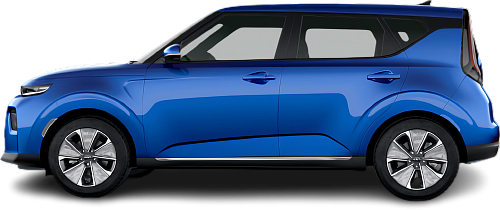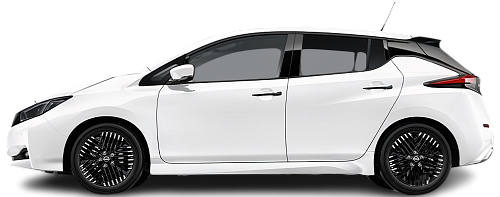USA EV Comparison: Kia Soul EV Long Range vs Nissan Leaf 60 kWh
Struggling to Decide? Let AI Help!
Your AI Summary Is Ready!
General Info
While the Kia Soul EV Long Range (2020-…) is currently produced, it is not offered for sale in the United States. The Nissan Leaf 60 kWh (2022-2025) has been discontinued. You can find it for as low as $11467 on the used car market.
The Kia Soul EV Long Range (2020-…) is a SUV, whereas the Nissan Leaf 60 kWh (2022-2025) is a Hatchback.
| Property | Kia Soul EV Long Range | Nissan Leaf 60 kWh |
|---|---|---|
| Years of Production | 2020-… | 2022-2025 |
| Current Status | Produced | Discontinued |
| Country of Manufacture | South Korea | Japan, UK, USA |
| Body Style | SUV | Hatchback |
| Market Availability | EU | EU, USA |
| Price USA (Used) | - Price USA (Used) | $11467 |
| GCC Score | 5.6 | 5 |
Range and Efficiency
The Kia Soul EV Long Range (2020-…) boasts a greater real-world range, a larger battery, and superior energy efficiency compared to the Nissan Leaf 60 kWh (2022-2025).
| Property | Kia Soul EV Long Range | Nissan Leaf 60 kWh |
|---|---|---|
| Range (EPA) | 243 mi | 212 mi |
| Range (WLTP) | 281 mi | 247 mi |
| Range (GCC) | 235 mi | 209 mi |
| Battery Capacity (Nominal) | 67.5 kWh | 60 kWh |
| Battery Capacity (Usable) | 64 kWh | 59 kWh |
| Efficiency per 100 mi | 27.2 kWh/100 mi | 28.2 kWh/100 mi |
| Efficiency per kWh | 3.67 mi/kWh | 3.54 mi/kWh |
| Range and Efficiency Score | 6.9 | 6.2 |
Charging
Both vehicles utilize a standard 400-volt architecture.
The Nissan Leaf 60 kWh (2022-2025) offers faster charging speeds at DC stations, reaching up to 100 kW, while the Kia Soul EV Long Range (2020-…) maxes out at 77 kW.
The Kia Soul EV Long Range (2020-…) features a more powerful on-board charger, supporting a maximum AC charging power of 7.2 kW, whereas the Nissan Leaf 60 kWh (2022-2025) is limited to 6.6 kW.
| Property | Kia Soul EV Long Range | Nissan Leaf 60 kWh |
|---|---|---|
| Max Charging Power (AC) | 7.2 kW | 6.6 kW |
| Max Charging Power (DC) | 77 kW | 100 kW |
| Architecture | 400 V | 400 V |
| Charge Port | CCS Type 2 | CHAdeMO |
| Charging Score | 4.5 | 3.8 |
Performance
Both vehicles are front-wheel drive.
The Nissan Leaf 60 kWh (2022-2025) boasts greater motor power and accelerates faster from 0 to 60 mph.
| Property | Kia Soul EV Long Range | Nissan Leaf 60 kWh |
|---|---|---|
| Drive Type | FWD | FWD |
| Motor Type | PMSM | PMSM |
| Motor Power (kW) | 150 kW | 160 kW |
| Motor Power (hp) | 201 hp | 215 hp |
| Motor Torque | 291 lb-ft | 251 lb-ft |
| 0-60 mph | 7.6 s | 6.8 s |
| Top Speed | 104 mph | 106 mph |
| Performance Score | 3.7 | 3.6 |
Dimensions
The Nissan Leaf 60 kWh (2022-2025) has a longer body, while the Kia Soul EV Long Range (2020-…) stands taller, offering a more elevated ride. Their widths are almost identical, so both offer a similar amount of shoulder room.
The Nissan Leaf 60 kWh (2022-2025) boasts a more extended wheelbase.
| Property | Kia Soul EV Long Range | Nissan Leaf 60 kWh |
|---|---|---|
| Length | 165.2 in | 176.4 in |
| Width (with Mirrors) | - Width (with Mirrors) | 79.9 in |
| Width (w/o Mirrors) | 70.9 in | 70.5 in |
| Height | 63.2 in | 61.7 in |
| Wheelbase | 102.4 in | 106.3 in |
Cargo and Towing
The Nissan Leaf 60 kWh (2022-2025) features a larger trunk, but the Kia Soul EV Long Range (2020-…) offers greater maximum cargo capacity when the rear seats are folded.
Neither car is equipped with a frunk (front trunk).
Neither vehicle is officially rated for towing in the US.
| Property | Kia Soul EV Long Range | Nissan Leaf 60 kWh |
|---|---|---|
| Number of Seats | 5 | 5 |
| Curb Weight | 3876 lb | 3901 lb |
| Cargo Volume (Trunk) | 11.1 ft3 | 23.6 ft3 |
| Cargo Volume (Max) | 47.3 ft3 | 30 ft3 |
| Cargo Volume (Frunk) | - Cargo Volume (Frunk) | - Cargo Volume (Frunk) |
| Towing Capacity | - Towing Capacity | - Towing Capacity |
| Cargo and Towing Score | 5.5 | 4.6 |




